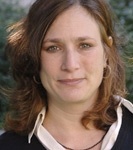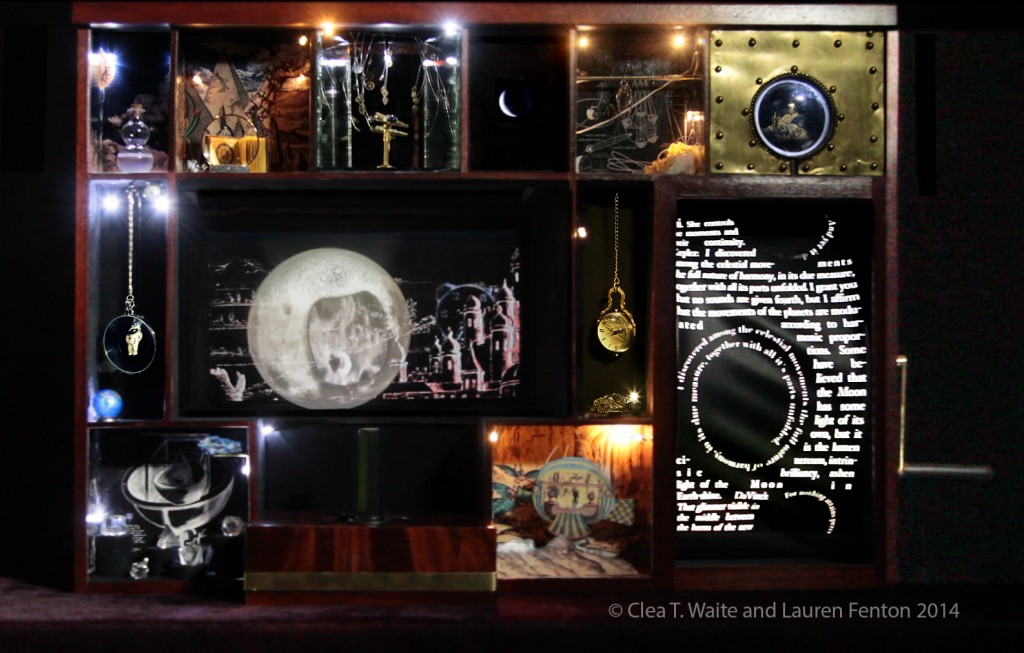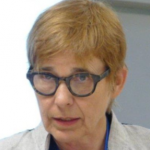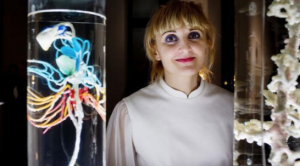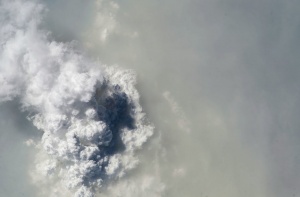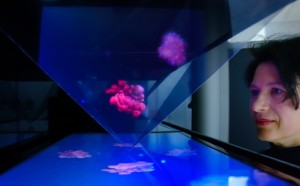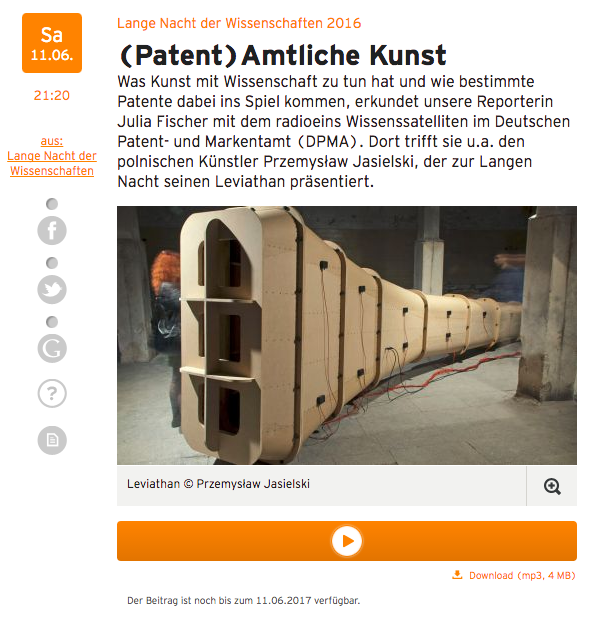Long Night of Sciences 2016
At GPTO in cooperation with ASN, Creativity & Innovation: Art Meets Science at the DPMA-TIZ Long Night of Sciences 2016.
Art & Innovation I: The Technical Information Center of the German Patent and Trademark Office (DPMA-TIZ) brought together art and innovation. Renowned artists from Germany, Poland, Switzerland, Turkey, and USA showed their works with selected patents.
The Long Night of Sciences 2016 event provided people with the opportunity to experience how technical and scientific innovations inspire contemporary artists working with various media.
The foyer was used to present the following:
Book of Luna” by Clea T. Waite
“Jelly Eyes” by Jill Scott (in progress documentation)
“Artists in Labs ” by Marille Hahne
“Distilling the Sky” by Pinar Yoldas
“Philosophers’ Stone” by Joanna Hoffmann
In addition, to the interactive construction “Leviathan” by Przemysław Jasielski – together with related patents.
The Long Night of Sciences 2016 exhibition presented various ways in which our increasingly technical-scientific world enters the world of art and culture. While allowing us to consider how the new comes into the world? What happens when science meets art? What is the role of patents?
Long Night of Sciences 2016 Guided tours
Guided tours with international scientists, artists, and experts and encouraged people to learn about their different perspectives. Experts who explained the connections between the artwork and the accompanying patents. Tours were facilitated by:
Kerstin Piratzky, the Head of TIZ Berlin / DPMA
Prof. Dr. Jill Scott, founder of the “Artists in Labs” Program, ZHDK Zurich
Prof. Marille Hahne, Filmmaker, ZHDK Zurich.
The President of the German Patent and Trademark Office Cornelia Rudloff-Schäffer opened the event in the presence of visitors and invited guests. Other speakers were Kerstin Piratzky, Head of TIZ Berlin / DPMA and Prof. Joanna Hoffmann, Chair of the Art Science Node (ASN).
Long Night of Sciences 2016 speakers:
– President of German Patent and Trademark Office (GPTO), Cornelia Rudloff-Schäffer
– Chair of Art & Science Node (ASN), Joanna Hoffmann, Prof. Dr. hab. Opening speech of Joanna Hoffmann, Chair of ASN’
-Head of the Technical Information Center (TIC) of the GPTO, Kerstin Piratzky.
Long Night of Sciences 2016 Artists and Works:
Clea T. Waite: Metabook: the Book of Luna in cooperation with Lauren Fenton (USA)
Dr Clea T. Waite is an intermedia artist-researcher and experimental filmmaker. Her projects focus on particle physics, astronomy, climate change, water ecology, and the history of science, themes she juxtaposes with mythology, poetry, literature, and pop culture.
She was a Fellow at the Alexander von Humboldt Foundation, the Radcliffe Institute for Advanced Studies Fellow, Academy of Media Arts Cologne, Academy of Film and Television Babelsberg, Germany, Pratt Institute, New York, and the University of the Arts Berlin and Annenberg Fellow at the University of Southern California School of Cinematic Arts. Her numerous residencies include the CERN European Laboratory for Particle Physics. Awarded i.a. by the IBM Innovation Prize for Artistic Creation in Art and Technology and the grand prize at the Computer Graphics Grand Prix in Tokyo.
MetaBook: The Book of Luna is an expanded cinema installation, an electronic Wunderkammer crossed with an illuminated manuscript that narrates a poetic essay about the Moon’s place in the historical imagination. The nature of love, madness, the unknown, and our capacity for the sublime are amongst the passions that have crystallized around our only satellite. The MetaBook is an immersive experience that combines the dynamic possibilities of the digital archive with the intuitiveness of the book and the engagement of cinema inviting the reader to navigate between the lunar craters or just float between them in a constant orbit. Clea T Waite
Jill Scott: Jellyeyes – Evolution And Vision – Documentation
Dr Jill Scott is Professor for Art and Science Research in the Institute of Cultural Studies in the Arts, at the Zurich University of the Arts, Founder of the Artists-in- Labs Program and Vice Director of the Z-Node PHD program on art and science at the University of Plymouth, UK.
Her artwork spans 38 years of media art production about the human body, behavior and body politics and recently on neuroscience, ecology and sensory perception. Her most recent art works involve the construction of interactive media and electronic sculptures based on studies she has conducted in residence in neuroscience labs at the University of Zurich, called »Neuromedia« Her publications with Springer include Neuromedia: Art and Science Research with Esther Stoeckli (2012), Transdiscourse 1: Mediated Environments (2011) and Artists-in-labs: Networking in the Margins (2011). The Documentation of JELLYEYES shows excerpts of the digital imaging from the augmented reality installation,which was premiered in Australia at the CREATIVE INDUSTRIES PRECINCT, Queensland University of Technology. (19 July-August 20th 2016)
 The main aim of JELLYEYES by the Swiss-Australian media artist Jill Scott is to raise public awareness about the evolution of vision and to allow for post-reflection through immersive interactions with three concepts of evolution: co-evolution, structural evolution, and completion. The viewer stands inside a semi-circular photograph of the Barrier Reef holding a tethered iPad that can be used to see this underwater world in real time. By pointing the iPad to different parts of the photo wall, the viewer can explore analogies of visions and sounds to reflect upon how evolution of vision is related to movement, survival and the environment. Here, the human eye can be compared to the way that two other species see the world (the Australian box jellyfish and the calamari) with whom humans share similar morphological characteristics and an evolutionary past. JELLYEYES allows viewers to discover scientific molecular knowledge about evolution as well as poetic metaphors and artistic interpretations about environmental and behavioral developments. In addition, various narratives can be explored such as humorous interactions between two characters in the sea, the hunter (tourist) and the collector (scientist). JELLYEYES also gives homage to the evolutionary biologist Lyn Margulis (1938-2011), whose theory on “endosymbiosis” inspired this augmented reality installation.Collaborators: Prof. Dr. Stephan Neuhauss, Neurobiology, Zürich University | Dr. Lisa-Ann Girshwin, Australian Marine Stinger Advisory Services | Nikolaus Völzow, Programmer ZKM Karlsruhe | Prof. Dr. Jill Scott, Prof. Marille Hahne, Natasha Jankovski, AIL Production Studio am Wasser, Zürich. With generous support from Pro Helvetia, the Swiss Arts Council and the HFF Munich Film School.Jill Scott
The main aim of JELLYEYES by the Swiss-Australian media artist Jill Scott is to raise public awareness about the evolution of vision and to allow for post-reflection through immersive interactions with three concepts of evolution: co-evolution, structural evolution, and completion. The viewer stands inside a semi-circular photograph of the Barrier Reef holding a tethered iPad that can be used to see this underwater world in real time. By pointing the iPad to different parts of the photo wall, the viewer can explore analogies of visions and sounds to reflect upon how evolution of vision is related to movement, survival and the environment. Here, the human eye can be compared to the way that two other species see the world (the Australian box jellyfish and the calamari) with whom humans share similar morphological characteristics and an evolutionary past. JELLYEYES allows viewers to discover scientific molecular knowledge about evolution as well as poetic metaphors and artistic interpretations about environmental and behavioral developments. In addition, various narratives can be explored such as humorous interactions between two characters in the sea, the hunter (tourist) and the collector (scientist). JELLYEYES also gives homage to the evolutionary biologist Lyn Margulis (1938-2011), whose theory on “endosymbiosis” inspired this augmented reality installation.Collaborators: Prof. Dr. Stephan Neuhauss, Neurobiology, Zürich University | Dr. Lisa-Ann Girshwin, Australian Marine Stinger Advisory Services | Nikolaus Völzow, Programmer ZKM Karlsruhe | Prof. Dr. Jill Scott, Prof. Marille Hahne, Natasha Jankovski, AIL Production Studio am Wasser, Zürich. With generous support from Pro Helvetia, the Swiss Arts Council and the HFF Munich Film School.Jill Scott
Artists in Labs
Z Node
Marille Hahne
Marille Hahne is a filmmaker, working primarily as a documenter of artists’ work. She has authored 40 film and video works and collaborated with many international media artists. She is Professor of the Zurich University of the Arts.
Since 2003, the Artists-in-Labs Program has placed over 40 artists into many different kinds of science labs in the life sciences, physics, cognition, computing and engineering. The program has evolved through various stages, but in this presentation, for the Patent Office we have made a selection of those artists who have worked in innovative labs where new discoveries have been made. The idea of the Artists-in-Labs Program is to give artists the opportunity to be immersed inside these cultures of scientific research, in order to develop their interpretations and inspire their content. Here artists have access to the solid raw materials, pertinent debates and scientific tools of the lab itself. The outcomes have helped scientists gain some insight into the semiotics of communication that is understood by artists to reach the general public. Our hope is to encourage further collaboration between both parties and foster the exchange of innovative ideas. Artists in Labs
Pinar Yoldas: Distilling the Sky
Pinar Yoldas is a cross-disciplinary artist/researcher based in Durham, North Carolina. Her work develops within biological sciences through architectural installations, kinetic sculpture, sound, video and drawing with a focus on post-humanism, eco-nihilism, anthropocene and feminist technoscience.
Her solo shows include AlterEvolution, Ekavart, Istanbul (2013), An Ecosystem of Excess, Ernst Schering Project Space, Berlin (2014), An Ecosystem of Excess ; Aksioma, Ljubljana. Her group shows include ThingWorld, NAMOC National Art Museum of Beijing (2014); Transmediale Festival, Berlin (2014); Tiere und Menschen, Museum Ostwall, Dortmund (2014), Polytech Museum, Moscow (2015), ExoEvolution at ZKM (2015) and 14th Istanbul Biennial (2015). Her work has been featured in Arte TV, Die Welt, The Creators Project , Art21 Blog, Der Spiegel, Vogue Turkey and Artlink BioArt issue to name a few.She is pursuing her Phd at Duke University at the Center for Cognitive Neuroscience and Media Arts and Sciences. She holds a Bachelors of Architecture from Middle East Technical University, a Master of Arts from Bilgi University, a Master of Science from Istanbul Technical University and a Master of Fine Arts from the University of California, Los Angeles where she worked at the Art|Sci Center and the UCLA Game lab. Her book An Ecosystem of Excess was published by ArgoBooks in 2014. Pinar is a 2015 Guggenheim Fellow.
DISTILLING THE SKY is an artistic research project on air quality and air pollution that is severely deteriorating in many cities around the world. The project aims to communicate environmental science and pollution research to the larger public as well as creating a platform for increasing public awareness
For this project, the artist would like to design a large scale mechanism or a group of architectural elements that can receive and “condense” polluted air into liquid form. From air to liquid, highly condensed drops of air pollution will become the ink for the calligraphers of the 21st century. As part of the project, the artist would like to present this poisonous ink to calligraphers in Beijing or in Istanbul, where the art of calligraphy still persists, or printmakers in Los Angeles and New York to ask one. The artists is working together with a team of scientists, experts and engineers who could actively support the design of Distilling the Sky. For the exhibition she will present some prototypes of these mechanisms at much smaller scales. Pinar Yoldas
Przemysław Jasielski: Leviathan
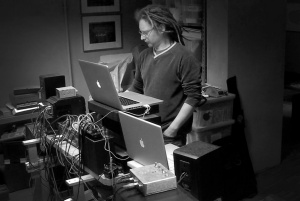
Przemysław Jasielski graduated from the University of Arts in Poznan. He is known for his installations and sculptures combining art with science and technology. Many of his works are “site specific” and interactive allowing the viewer to see the daily environment in a different way. His works usually contain specific, critical sense of humour that is not ironic or cynic, but questioning. They often perform in a way which can be perceived as impossible, useless or “ineffective”.
Przemysław Jasielski’s works have been presented internationally in Europe, Canada, USA and Japan.
The Leviathan project combines the artist’s previous search in the realm of technology and sound with his fascination with the utopian visions of the world dominated by machines. It is an attempt to create an artificial electronic organism showing the features of a living creature. The object is covered with sensors reacting to touch and emits various sounds and vibrations as a result of interaction with the audience. Leviathan contradicts the privileged position of a human being as regards technology and the utilitarian use of the machine. It grants the machine its own subjective identity. This unique object takes up a game with the economics of desire too. Unlike devices and gadgets purchased on a mass scale, which are to improve our lives or provide entertainment, Leviathan remains non-assimilated and in its own way – passive. It is an “alien/other”, a thing coming from a different order of reality, unpredictable and self-controllable.
Joanna Hoffmann: Philosophers‘ Stone (music: Dave Lawrence)
Joanna Hoffmann (Dr hab) is Professor of the University of Arts in Poznan, where she leads the Studio for Transdisciplinary Projects & Research AE/UAP. She is also co-founder and Chair of the Art & Science Node in Berlin.
Her artistic works have been widely presented i.a.: at the Center for Contemporary Arts (Warsaw); Science Museum/DANA Centre (London); MOCA Museum of Contemporary Art (London); Transmediale Festival (Berlin); EPO European Patent Office, Berlin; WRO Media
Art Biennale (Wroclaw); MUSE Centre of Photography and the Moving Image (NewYork); BioQuant Centre (Heidelberg, DE); Hiroshima City Museum (J). She was an artist in residence at i.a.: Eilslabs/DKFZ /Heidelberg University; Academy of Film and Television Potsdam- Babelsberg DE; CEMA Centre for Electronic Media Art/Srishti College & NCBS National Centre of Biological Science, Bangalore (lN); KHOJ & ICGEB International Centre for Genetic Engineering and Biotechnology New Delhi (lN); Reiterated Fellow of the Polish Minister of Culture.
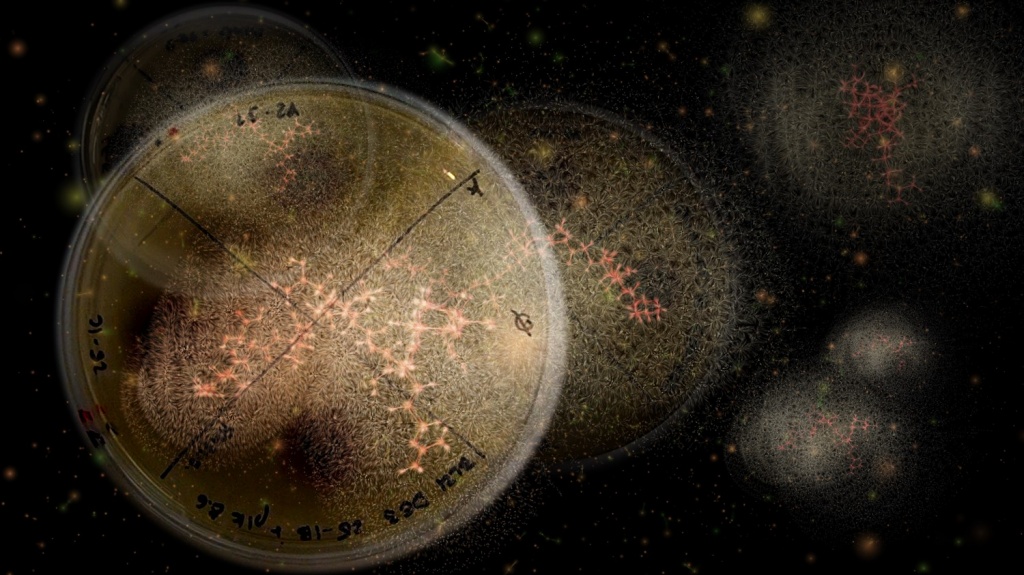
“Philosophers’ Stone” was realised in collaboration with the iGEM Team, EilsLab/DKFZ/University of Heidelberg (Grand Prix iGEM Boston 2013) http://2013.igem.org/Team:HeidelbergThe scientific research was inspired by the bacterium Delftia acidovorans, which is known for generating a peptide called Delftibactin used to detoxify soluble gold and to create golden nanoparticles. . By experimenting with E-coli bacteria, scientists aim to verify the potentiality of non- ribosomal peptides synthesis not only in recycling gold from electronic waste but also in pharmaceutical and basic research.
“PHILOSOPHERS’ STONE” juxtaposes contemporary scientific practice with alchemic phases of Magnum Opus with a particular interest in the philosophers’ stone seen as a metaphor for deeper and consistent knowledge (leading to wisdom), internal transformation and higher ethical values. The film refers to the deepest human emotions and desires, questioning the notion of philosophers’ stone in the age of molecular revolution.
Joanna Hoffmann
Trans disciplinary Art



